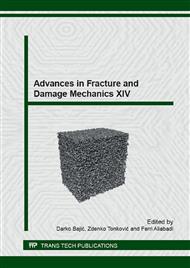p.13
p.17
p.21
p.25
p.29
p.33
p.37
p.41
p.45
Experimental Tensile Tests on Bone Cement: Effect of Test Sample Shape
Abstract:
Objectives: The mechanical characteristics of bone cement depend on the chemical composition, mixing technique, polymerization period and temperature. Additionally, the shape of the cement mantle can also lead to variations in the mechanical properties of the material, as thicker walls are significantly more non-homogeneous and less permeable for the body fluids. This paper presents experimental tensile tests on bone cement focused on the study of the influence of the test specimen shape on the obtained results.Methods: High viscosity bone cement, produced and supplied as polymer powder and monomer liquid portions was used. The mixed cement was inserted during the working time into two types of silicon molds: one with the shape and size according to ISO 527 (“dogbone” shape with rectangular cross section area) and other with the shape and size according to ASTM F 2118 (“dogbone” shape with circular cross section area). Both types of test specimens have approximately the same value of the cross sectional gauge area. All samples were polished with grit abrasive paper in the longitudinal direction and soaked in phosphate buffered saline (PBS) solution. The specimens were subjected to a tensile test on a hydraulic machine. To avoid the occurrence of critical stress areas on the specimen, special fixing devices were manufactured.Results and conclusions: The stress–strain curves of all specimens tested exhibited similar linear elastic regime followed by brittle fracture. However, different values of the ultimate tensile strength and elastic modulus of tested samples were recorded.
Info:
Periodical:
Pages:
29-32
Citation:
Online since:
September 2015
Authors:
Price:
Сopyright:
© 2016 Trans Tech Publications Ltd. All Rights Reserved
Share:
Citation:


